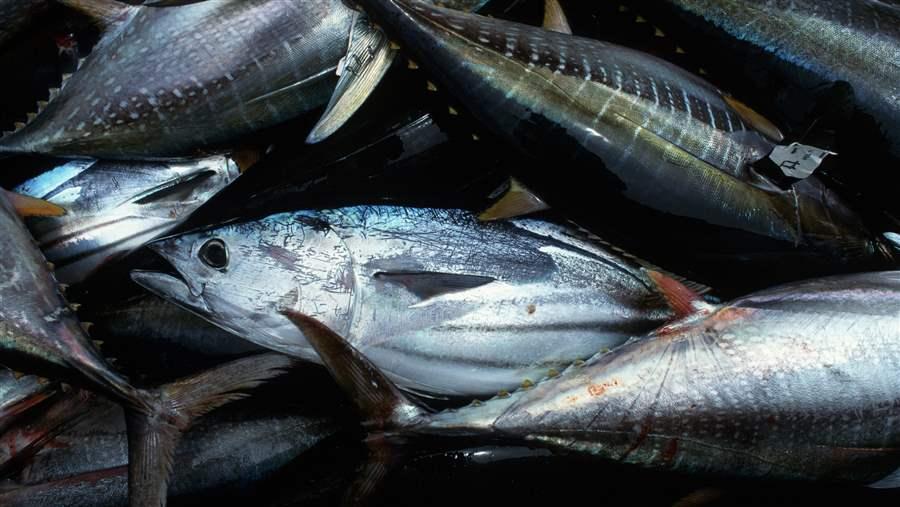What Will It Take to End the Stalemate in the Western and Central Pacific?
Tuna management meeting ends with little progress in protecting declining populations
 Richard Hermann/Seapics
Richard Hermann/SeapicsSkipjack and yellowfin tuna.
It would be impossible to sustainably manage the world’s largest tuna fishing grounds without international cooperation. Yet the need to reach consensus among dozens of countries with diverging priorities makes the process of finding approaches that work far too slow in the western and central Pacific Ocean.
This December, members of the Western and Central Pacific Fisheries Commission (WCPFC) concluded their annual meeting in Bali, Indonesia, with no new steps to end the overfishing of bigeye or Pacific bluefin tunas. They also could not reach agreement on measures to improve shark conservation and further eradicate illegal fishing. It wasn’t for a lack of trying on the part of some parties. Most commission members agree that the status quo is unsustainable, and the commission chair, Rhea Moss-Christian from the Federated States of Micronesia, pushed hard for action and compromise.
On the positive side, the commission did adopt an interim target reference point for skipjack tuna and set a timeline for developing much needed harvest strategies for major species of commercially fished tunas in the Pacific.
Still, consensus proved elusive on many substantive policy issues up for consideration, and ultimately the commission’s actions fell short in addressing some of the basic principles of fisheries management.
Bigeye overfishing will continue
Commission members did not agree on new measures to end overfishing of bigeye tuna. That means that there will be no reduction in bigeye catches and no limits on the number of fish aggregating devices (FADs) that vessels can deploy. The region’s bigeye population is overfished and now stands at just 16 percent of unfished levels. Current measures have not worked to sufficiently rebuild the bigeye’s numbers.
No end to decline in Pacific bluefin population
Commission members broadly acknowledged the dire state of Pacific bluefin tuna but did not direct the WCPFC Northern Committee to take any specific steps to reverse the declines. The population is at just 4 percent of unfished levels; scientists warn that the numbers will continue to drop until 2018 under current measures.
Movement on harvest strategies for tuna stocks
One bright spot came with agreement on a work plan for developing harvest strategies for most of the region’s commercially fished tuna stocks. Last year, the commission committed to developing and implementing a six-part harvest strategy work plan for each of the key tuna fisheries. These strategies spell out steps to develop, test, and establish long-term, science-based approaches to managing a fishery, rather than managing a stock already in crisis.
For skipjack tuna, the commission agreed to a target reference point, which identifies the ideal level of fishing for a stock. This target follows scientific advice and is considered precautionary.
Still no minimum standard for port controls
Commission members again failed to adopt minimum standards to guide countries in the implementation of port controls, a critical tactic used to fight illegal fishing. This is the sixth consecutive year that they were unable to adopt these baseline standards. Port state measures are cost-effective tools for monitoring compliance with management arrangements and preventing illegally caught fish from entering the market.
Commission members also took no action to stop at-sea transshipments for longline vessels. Transshipment at sea—transferring a vessel’s haul to another ship—provides opportunities for those fishing illegally to avoid reporting catch and to launder illicitly caught fish.
Members did agree, however, to update the commission’s vessel monitoring system (VMS) standards for reporting data properly to the Secretariat. Under the new rules, if specific VMS unit types cannot meet the new standards, they would have to be phased out of service within three years.
Progress on shark management plans
While there was little on the table for sharks at this year’s meeting, the commission made progress in developing draft guidelines for shark management plans. Members told the Secretariat to come up with a definition of a targeted shark fishery and to create a list of key elements to be included in shark management plans for fisheries that target sharks.
Despite this incremental progress, the amount of time members spent negotiating the future of bigeye tuna alone—with no resulting steps to end overfishing—prevented discussion on other important measures to protect declining shark populations and help enforcement agencies curtail illegal fishing.
If the commission is to live up to its mandate, members must use the next year to work through differences, find compromise solutions, and build much-needed consensus. Without that, the sustainability of the world’s largest tuna fishing grounds remains in question. Pew and other organizations have been offering support along the way and will continue to do so.
Amanda Nickson directs global tuna conservation at The Pew Charitable Trusts.











